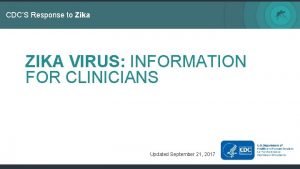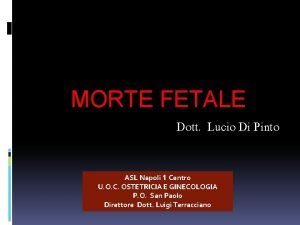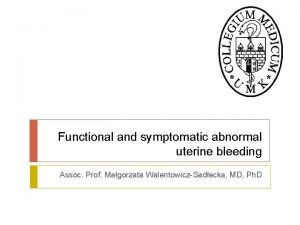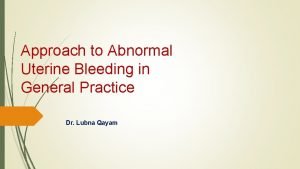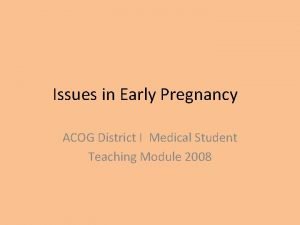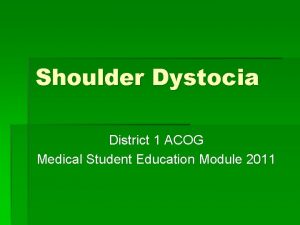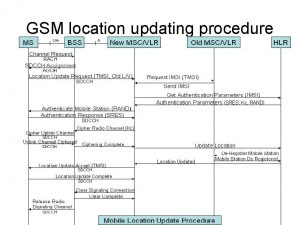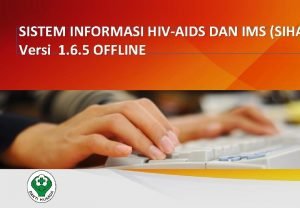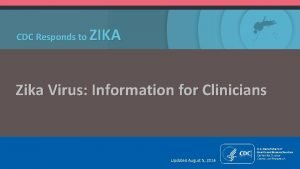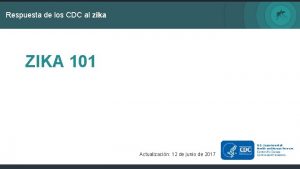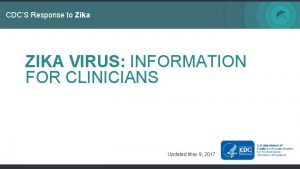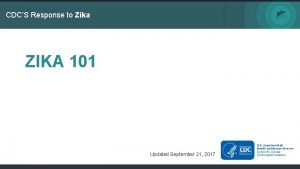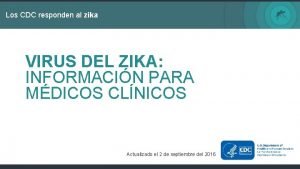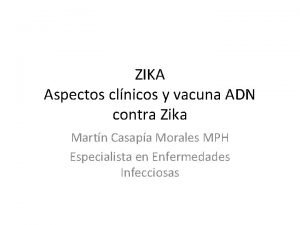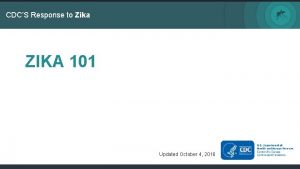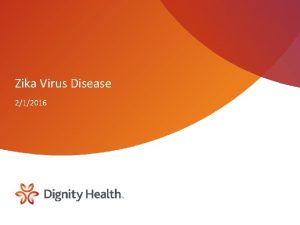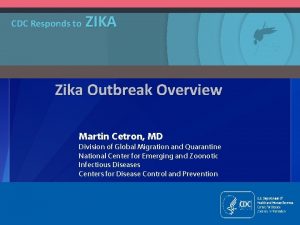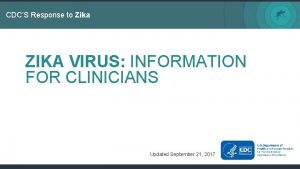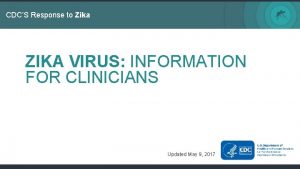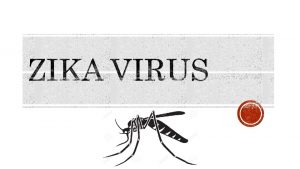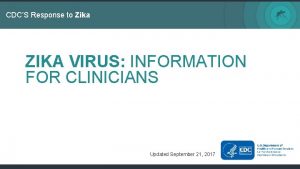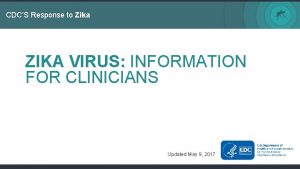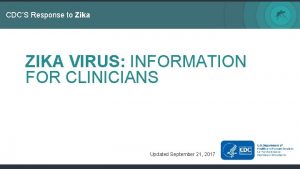Zika Update What Weve Learned So Far ACOG

















































- Slides: 49

Zika Update: What We’ve Learned So Far ACOG District XII Annual District Meeting Orlando, FL: August 11, 2017 Neil S. Silverman, M. D. Clinical Professor, Obstetrics and Gynecology Division of Maternal-Fetal Medicine David Geffen School of Medicine at UCLA Member, ACOG Zika Expert Work Group

Aedes aegypti

Zika – Disease and Risks

Background o Zika virus is an arbovirus transmitted to humans primarily through the bite of infected Aedes sp. mosquito • Nearly all Zika outbreaks due to aegypti & albopictus • These are the same mosquitoes that transmit dengue and chikungunya - Dengue and Zika are flaviviruses (YF) ; chikungunya: alphavirus - West Nile also arbovirus/flavivirus, but spread by Culex sp. • The mosquito vectors typically breed in domestic waterholding containers • Aegypti -- high “vectorial capacity”: feeds primarily on humans, multiple humans in a single meal, lives close to humans , also daytime and nighttime feeders

Clinical Disease o About 20% of people infected with Zika virus become symptomatic o Among those with clinical illness • Symptoms mild, typically develop within 1 week from exposure, lasting several days to a week • Characteristic clinical findings: acute onset of fever, maculopapular rash, arthralgia, or conjunctivitis. • Severe disease requiring hospitalization is uncommon and fatalities are rare. o Guillain-Barré syndrome also has been reported at increased rates in patients following Zika infection

Clinical Features of Zika Virus Infection in Pregnant Women. Brasil P et al. N Engl J Med 2016. DOI: 10. 1056/NEJMoa 1602412

Brazil Zika Outbreak o May 2015: First infection in Brazil o October 2015: increase in microcephaly

Microcephaly: the tip of the iceberg? o Microcephaly is a very specific diagnosis, and typically unusual as an isolated finding: initially seen in newborns • On ultrasound, defined as HC < 3 SD for GA (SMFM, 2016)* • HC < 2 SD for GA should trigger more detailed eval and f/u o Microcephaly became an early trigger to search for Zika association, but spectrum of disease became apparent • Microcephaly can occur as a result of a fetal brain disruption sequence: this appears to be pathology of Zika infection * ref: Chervenak FA, et al, AJOG 1984

Zika Associated Pregnancy Outcomes o Fetal loss/miscarriage, stillbirth o Fetal growth abnormalities o Fetal brain anomalies • Microcephaly • Ventriculomegaly • Intracranial calcifications o Eye abnormalities o Neurologic • Hypertonia • Arthrogryposis • Seizures Miranda-Filho et al, AJPH April 2016, Vol 106 No. 4

Long Term Pregnancy Outcomes: Evolving o Update on 13 infants born without microcephaly but ZKVinfected (Brazil) • Neuroimaging abnormal in all: all w/ ↓ brain volume, +/or ↑ vents • 11 referred for small head size but > 2 SD, 2 for devel. lag (5, 7 mos) • 10 w/dysphagia, 3 w/chorioretinitis, all hypertonic (MMWR 11/16) o Recent Brazil cohort Zin AA, et al. JAMA Pediatrics 7/17/17 • 112 mother-infant pairs w/confirmed maternal infx • 64% of infants Zika (+), 21% of those with eye abnl • 10/24 with eye findings (42%) did not have microcephaly, while 8 (33%) had no CNS findings o Anticipate a spectrum of outcomes? • Developmental and/or intellectual delay • Motor abnormalities

Pregnancy Risk Estimates o Brasil et al: Rio cohort 1 • Prospective study cohort of 134 symptomatic pregnant women with confirmed ZKV infection • Overall, 49/117 (42%) liveborn ZKV-exposed infants had abnormal findings by 1 st month of life [5% in ZKV(-): p< 0. 001] o Adverse outcomes seen regardless of trimester of infx • 55% risk if maternal infx in 1 st, 52% if in 2 nd, 29% if in 3 rd o Updated report from US Zika Pregnancy Registry 2 • Birth defects related to Zika in 6%, 21 in live births • No risk difference regarding sx; 11% risk if exposure in 1 st ∆ • Data from US territories: 5% of fetuses/newborns affected (MMWR 6/18/17) - Outcomes from 2624 at-risk pregnancies, 1/16 through 4/17 1. Brasil et al, NEJM 12/16. 2. Honein M et al, JAMA 12/13/16

Zika – Where is it and where is it not?

As of July 2017: CDC. gov




Zika in the US: as of Aug 9, 2017 US States/DC (5413 cases): 200 in 2017 o Travel-associated Zika virus disease cases reported: 5140 (49 other routes) o Locally acquired vector-borne cases reported: 224 • In 2017: all travel cases so far , exc 1 local and 1 sexual US Territories o Travel-associated cases reported: 147 (0 in 2017) o Locally acquired cases reported: 37007 (including 553 so far in 2017) • 51 cases of Guillain-Barre syndrome CDC. gov

Current Zika Statistics (as of 7/25/17) • 2086 pregnant travelers with laboratory evidence of Zika virus in US States and DC – vast majority imported/travel-related o 1784 completed pregnancies o 91 reported liveborn infants and 8 fetal losses with Zika related birth defects • 4341 pregnant cases in US territories (mostly Puerto Rico) --- 3051 completed, 128 affected liveborns


Local Zika Transmission in FLA, TX • Pregnant women had been counseled to avoid travel to or sexual contact with those who traveled to Miami-Dade, FLA and Brownsville, TX – After 8/1/16 for Miami-Dade; 10/29/16 for TX • Travel restrictions lifted June 2, 2017 for Miami. Dade – still cautionary for south Texas • New local case (1 st US for 2017) in S Texas (7/24) – 1 st sexual transmission case in FLA 8/1/17 (Pinellas) • Biggest risk in U. S. still remains travel exposure

Through Aug 9, 2017

Gulf Coast States: Zika’s Potential Economic Risks o Recent study reports on economic model to estimate Zika-related costs in 6 Gulf-area states • ALA, FLA, GA, LA, MISS • Modeled for a 230 -day outbreak, based on Brazil duration o Cost estimates based on both direct medical costs and productivity losses due to illness or adverse outcomes (including poor pregnancy outcomes) • Model included Medicaid and commercial costs, screening tests and, for pregnancy, ultrasound surveillance o Modeled for Zika attack rates from 0. 1% to 10% • Even an attack rate of 1% (far lower than rates seen in French Polynesia/Micronesia outbreaks) resulted in total economic impact of $1. 2 billion Lee BY, et al. PLOS Negl Trop Dis, 4/27/17


Zika – Education and Testing

What do we tell our pregnant patients? o How much fetal risk with confirmed maternal infection? • Based on current data, range may be as high as 29% • Rates are derived from methodologically diverse studies o Despite earlier reports, recent data suggest later GA at infection does not exclude potential adverse impact o Pregnant women should not travel to areas with active Zika transmission

The role of prevention o If in an area with transmission, protection and prevention strategies are important – and repellent for 3 weeks after return from these areas o DEET, picaridin fine for use in pregnancy • Consumer Reports (Sept 2017): Deet at 15 -30% concentrations works best, picardin 20% (spray, not lotion), oil of lemon eucalyptus 30% (Repel better than Coleman) o Review article on repellents in Zika era: Wylie B, et al. Ob. Gyn 11/16



What informed the new testing guidelines? o While consequences of Zika infection are better understood, accurate diagnosis continues to be challenging • Virus present in body fluids only transiently • Serologic testing (Ig. M) can’t always reliably time infection • Serology prone to false-positive results and cross-reaction with other flaviviruses o With declining prevalence of Zika infection, probability of false-positive tests increases o Changing epidemiology further limits diagnostic capabilities of existing tests

Persistence of NAT and Immune Responses o Early data: Zika RNA detected up to 7 days after symptoms • Zika Persistence Study (Zi. Per: NEJM, 2017*) of persons with NATconfirmed infection reported detection 8 -15 days after sx in 36%, 16 -30 days in 21%, > 60 days in 4% • Some series have shown extended viral persistence in pregnancy • Viral detection may exist longer in urine than in blood o Zika Ig. M: typically detected with 1 st 2 wks after symptoms • Published data limited but Zi. Per Study showed Ig. M (+) after sx after 0 -7 days in 34%, 8 -15 days in 100%, > 60 days in 80% • Median of 4 months (8 -210 days) to 1 st negative Ig. M result • Detection of Ig. M antibodies might not indicate infection in current pregnancy *Paz-Bailey G, et al. NEJM 2017: doi. org/10. 1056/NEJMoa 1613108

Zika Immunity o Presumption has been that Zika infection confers immunity after the Ig. M response o Based on experience with other flaviviruses, previous Zika infection is likely to confer prolonged, likely lifelong immunity • If true, prior infection would prevent risks for a future pregnancy o However, no commercially-available Ig. G testing exists, and Ig. M duration limited o New tests on the horizon. . NS 1 -based

New guidelines – what do the changes reflect? o As many areas in the Americas move into a 2 nd or 3 rd mosquito season after introduction of Zika virus, testing becomes more complex o Given the evolving epidemiology and the betterrealized limitations of testing, updated testing algorithms for symptomatic and asymptomatic pregnant women emphasize a shared decisionmaking model o Pre-and post-test counseling, with results interpreted in context of limitations

New guidelines: what’s the same (mostly)? o Screen pregnant women for Zika exposure risk and/or symptoms at every prenatal and hospital visit • Knowledge of potential exposure before and during pregnancy is critical information for test interpretation o Symptomatic pregnant women with recent possible Zika exposure: testing still recommended • Concurrent NAT (blood/urine) and Ig. M as soon as possible, through 12 weeks post-exposure (can consider if > 12 wks, but. . ) o Pregnant women with exposure and u/s findings: still test o Asymptomatic women with ongoing possible Zika exposure: testing still offered once/trimester • NAT testing of blood and urine, not Ig. M (diagnostic limits)

New guidelines: what’s different (mostly) o Asymptomatic women with recent possible Zika exposure but not ongoing exposure • Testing now not routinely recommended for this group • BUT: shared-decision making and consideration of local/regional epidemiologic risks involved for this group • CDC acknowledges that data indicate that while perinatal Zika risk doesn’t differ by maternal symptoms, routine testing in a low-prevalence group increases risk of falsepositives in absence of any prevention or therapies • If testing done, default to algorithm for symptomatic/no ongoing exposure: PCR and Ig. M o Currently: CA, FL, TX staying with prior guidelines

Confirmed Zika Cases in Mexico by State January 1, 2016 – August 8, 2016 0 confirmed cases 1 – 25 confirmed cases ja C Ba 26 – 50 confirmed cases ia orn alif Sonora 51 – 100 confirmed cases Chihuahua More than 100 confirmed cases Durango Nayarit Lu is Ag. Po tos to jua a n a Yucatán i Guerrero Oaxaca Morelos Chiapas na inta Qu he ec Tabasc o Ca mp o Q ic M Puebla cru Ag. = Aguascalientes Quer. = Querétaro DF = Distrito Federal Tl. = Tlaxcala Tl. ra Ve z Data provided by the Mexican Ministry of Health http: //www. epidemiologia. salud. go b. mx/doctos/avisos/2016/zika/DG E_ZIKA_CASOS_SEM 028_2016. pdf Mi algo DF Colima n acá o ch Hid éx Gu Jalisco ue r . N = 1, 490 Za as Ro o ec S an t ca Tama ulipa loa na Si ia orn alif Nuevo León s ja C Ba r Su Coahuila

Confirmed Zika Cases in Mexico by State January 1, 2016 – July 3, 2017 0 confirmed cases 1 – 25 confirmed cases s to jua a n H a i Yucatán cru Puebla Oaxaca Morelos Chiapas na inta he Tabasco Guerrero Qu Tl. ec o Q lgo ra Ve z DF Mi n acá o ch ida ic Gu ue r . rit ya Ag. = Aguascalientes Quer. = Querétaro DF = Distrito Federal Tl. = Tlaxcala Po éx Na is Ag. Jalisco Colima Lu Ro o as ec t a Sa ac n Tama ulipa Durango M loa ia na orn Nuevo León Z Data provided by the Mexican Ministry of Health https: //www. gob. mx/cms/uploads/ attachment/file/223168/Cuadro_C asos_ZIKA_y_Emb_SE 26_2017. p df More than 100 confirmed cases Si alif ja C Ba r Su Coahuila mp ia orn alif 51 – 100 confirmed cases Chihuahua Ca ja C Ba 26 – 50 confirmed cases Sonora


Sexual Partner concerns/guidelines • Sexual transmission of Zika virus can occur - Male/female, female/male, male/male all reported • Pregnant women whose male partners at risk for Zika virus infection should consider using condoms or abstaining from sexual intercourse – duration of pregnancy – Zika in semen up to 6 mos. • Zika has recently been shown to cause testicular damage in mouse models (Govero J, et al. Lancet Dec 15, 2016) - ZKV persistence in testis/epididymis→ tissue injury resulting in diminished testosterone and inhibin B levels and oligospermia

Zika “waiting periods” – counseling for OBGYNs o Timeframes to wait to get pregnant after travel to an area with a CDC travel notice (CDC 7/17) • Women -- 8 weeks Men -- 6 months • If both partners traveled, wait 6 months + condoms o Egg and sperm donors (ASRM, 3/16) • Wait period 6 months after infx, travel, or contact o Blood donors (FDA, 2/16) • 4 week waiting period

Zika Resources o CDC Zika website: www. cdc. gov/zika o ACOG’s Zika webpage: www. acog. org/zika o Florida • www. floridahealth. gov/diseases-andconditions/zika-virus


Neonatal coordination is Critical!

Which newborns need Zika surveillance? o Zika testing for in 1 st two days after birth for infants at risk: serum and urine for PCR, serum for Ig. M • Mothers with lab-confirmed infection • Abnormal clinical findings suggestive of congenital Zika and potential maternal epidemiologic link, regardless of maternal test results o All infants born to women with lab-confirmed Zika infection should get: • Zika testing, comprehensive exam, head ultrasound, and standard hearing assessment • Based on newer data, they should also get formal eye exam (not just red reflex testing)

Need for Neonatal Followup & Deficits o Recent report on 2549 completed pregnancies (1/16 -4/17) • 5% of fetuses/newborns of women in Puerto Rico with confirmed Zika infection had likely Zika-associated birth defects 1 • Of liveborns without birth defects, only 52% had postnatal neuroimaging and 78% had hearing screens o Recent US Pregnancy Registry Data worse (MMWR, 4/7/17) 2 • Among 895 liveborns with maternal infection: postnatal neuroimaging reported for 25%, Zika testing of at least 1 infant specimen 65% o While 98% of pregnant women in P. R. in a recent survey took at least 1 measure to avoid Zika infection, use of repellents (45%) and condoms (40%) during pregnancy overall low 3 1. Shapiro-Mendoza CK, et al, MMWR 6/8/17. 2. Reynolds M et al, MMWR 4/7/17. 3 D’Angelo DV et al, MMWR 6/9/17


Zika as an Endemic Infection o Zika virus is considered endemic in some countries, and a large number of local residents are likely to be immune. However, US travelers to endemic areas may not be immune to Zika virus and infections have occurred among travelers to Asia and Africa Updated 7/17

Aug 4, 2016

Plasmid-based vaccine: no live or attenuated virus 2500 study enrollees planned in high-risk areas to test both immunogenicity and efficacy No pregnant women to be enrolled

 Zika
Zika Is the zika virus lytic or lysogenic
Is the zika virus lytic or lysogenic Weve been lied to
Weve been lied to Weve got the beat
Weve got the beat What is virtual memory
What is virtual memory The lights from the parlour and kitchen shone out
The lights from the parlour and kitchen shone out We've a story to tell to the nations
We've a story to tell to the nations Is an alternative of log based recovery.
Is an alternative of log based recovery. Belled flowery tyrolese valley
Belled flowery tyrolese valley Sour cream walls is an example of pun
Sour cream walls is an example of pun In a kingdom far far away
In a kingdom far far away Far far away city
Far far away city Acog thyroid pregnancy
Acog thyroid pregnancy Acog classificazione ctg
Acog classificazione ctg Acog
Acog Acog flowsheet
Acog flowsheet Palm coein acog
Palm coein acog Blighted ovum acog
Blighted ovum acog Helper shoulder dystocia
Helper shoulder dystocia Ffm update
Ffm update Apollo gx55
Apollo gx55 Unity connection to the update server failed
Unity connection to the update server failed Oracle update with order by
Oracle update with order by 16 segmen coa
16 segmen coa Mentor update yorkshire
Mentor update yorkshire Gsm location update procedure
Gsm location update procedure Flash player update
Flash player update A tomato flames
A tomato flames Dokumen deskripsi sdmk
Dokumen deskripsi sdmk Microsoft security essential tidak bisa update
Microsoft security essential tidak bisa update Nepal research and education network
Nepal research and education network An update of wallace’s zoogeographic regions of the world
An update of wallace’s zoogeographic regions of the world Recovery techniques based on immediate update
Recovery techniques based on immediate update Is update countable or uncountable
Is update countable or uncountable Ruc 1
Ruc 1 Microsoft update
Microsoft update Application screen update false
Application screen update false F&b product knowledge
F&b product knowledge Fiberhome modem
Fiberhome modem Aptget update
Aptget update Iqcs nwcg
Iqcs nwcg Update debrecen
Update debrecen Gsm tdma
Gsm tdma Temporary update problem in dbms
Temporary update problem in dbms Apache server
Apache server Aplikasi siha offline
Aplikasi siha offline Raksha tpa claim
Raksha tpa claim Fall creators update whats new
Fall creators update whats new Microsoft update
Microsoft update Bankhead primary school
Bankhead primary school
